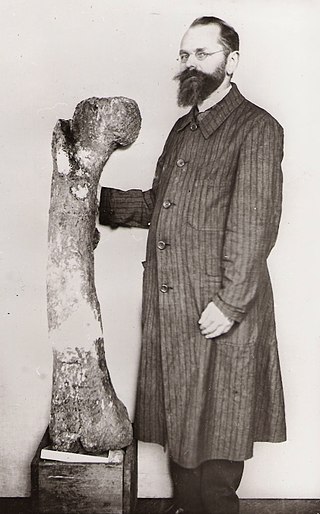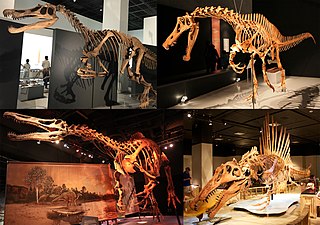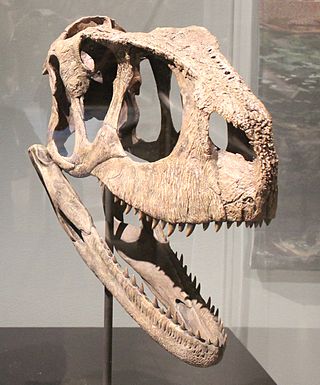
Spinosaurus is a genus of spinosaurid dinosaur that lived in what now is North Africa during the Cenomanian stage of the Late Cretaceous period, about 100 to 94 million years ago. The genus was known first from Egyptian remains discovered in 1912 and described by German palaeontologist Ernst Stromer in 1915. The original remains were destroyed in World War II, but additional material came to light in the early 21st century. It is unclear whether one or two species are represented in the fossils reported in the scientific literature. The best known species is S. aegyptiacus from Egypt, although a potential second species, S. maroccanus, has been recovered from Morocco. The contemporary spinosaurid genus Sigilmassasaurus has also been synonymized by some authors with S. aegyptiacus, though other researchers propose it to be a distinct taxon. Another possible junior synonym is Oxalaia from the Alcântara Formation in Brazil.

Carcharodontosaurus is a genus of carnivorous theropod dinosaur that lived in North Africa from about 100 to 94 million years ago during the Cenomanian stage of the Late Cretaceous. Two teeth of the genus, now lost, were first described from Algeria by French paleontologists Charles Depéret and Justin Savornin as Megalosaurus saharicus. A partial skeleton was collected by crews of German paleontologist Ernst Stromer during a 1914 expedition to Egypt. Stromer did not report the Egyptian find until 1931, in which he dubbed the novel genus Carcharodontosaurus, making the type species C. saharicus. Unfortunately, this skeleton was destroyed during the Second World War. In 1995 a nearly complete skull of C. saharicus, the first well-preserved specimen to be found in almost a century, was discovered in the Kem Kem Beds of Morocco; it was designated the neotype in 1996. Fossils unearthed from the Echkar Formation of northern Niger were described and named as another species, C. iguidensis, in 2007.

Ernst Freiherr Stromer von Reichenbach was a German paleontologist best remembered for his expedition to Egypt, during which the discovery of the first known remains of Spinosaurus was made.

Spinosauridae is a clade or family of tetanuran theropod dinosaurs comprising ten to seventeen known genera. Spinosaurid fossils have been recovered worldwide, including Africa, Europe, South America and Asia. Their remains have generally been attributed to the Early to Mid Cretaceous.

Aegyptosaurus is a genus of sauropod dinosaur that lived in what is now Africa, around 95 million years ago, during the Late Cretaceous Period.

Rugops is a monospecific genus of basal abelisaurid theropod dinosaur from Niger that lived during the Late Cretaceous period in what is now the Echkar Formation. The type and only species, Rugops primus, is known only from a partial skull. It was named and described in 2004 by Paul Sereno, Jeffery Wilson and Jack Conrad. Rugops has an estimated length of 4.4–5.3 metres and weight of 410 kilograms. The top of its skull bears several pits which correlates with overlaying scale and the front of the snout would have had an armour-like dermis.

Deltadromeus is a genus of theropod dinosaur from the Aoufous Formation of Morocco.

Rebbachisaurus is a genus of sauropod dinosaur of the superfamily Diplodocoidea, that lived during the Late Cretaceous period in Africa and possibly also South America about 99-97 million years ago. Remains attributed to Rebbachisaurus have been found in Morocco, Niger, Algeria, Tunisia and possibly also Argentina, although only the Moroccan remains can be referred to the genus without doubt. The discovery of Rayososaurus, a South American sauropod nearly identical to Rebbachisaurus which may have actually have been the same animal as Rebbachisaurus, supports the theory that there was still a land connection between Africa and South America during the Early Cretaceous, long after it was commonly thought the two continents had separated.
Inosaurus is the name given to a dubious genus of theropod dinosaur from the Early Cretaceous-aged "Continental intercalaire" and Early Cretaceous (Albian)-aged Echkar Formation of Niger and possibly from the Late Cretaceous (Cenomanian)-aged Baharija Formation of Egypt The type, and only species, is Inosaurus tedreftensis.

Sigilmassasaurus is a controversial genus of spinosaurid dinosaur that lived approximately 100 to 94 million years ago during the Late Cretaceous Period in what is now northern Africa. Named in 1996 by Canadian paleontologist Dale Russell, it contains a single species, Sigilmassasaurus brevicollis. The identity of the genus has been debated by scientists, with some considering its fossils to represent material from the closely related species Spinosaurus aegyptiacus, while others have classified it as a separate taxon, forming the clade Spinosaurini with Spinosaurus as its sister taxon.

Bahariasauridae is a potential family of averostran theropods that might include a handful of African and South American genera, such as Aoniraptor, Bahariasaurus, Deltadromeus, and Gualicho. The placement of these theropods is controversial, with some studies placing them as basal ceratosaurs possibly related to Noasauridae, others classifying them as megaraptorans, basal neovenatorids, or basal coelurosaurs. There is also a possibility the group might not be monophyletic, as a monograph on the vertebrate diversity in the Kem Kem Beds published in 2020 found Bahariasaurus to be nomen dubium. In the same paper Deltadromeus is classified as an noasaurid, a result also recovered by some previous studies. A 2024 analysis found Aoniraptor, Bahariasaurus, Deltadromeus, Elaphrosaurus and Gualicho to form a monophyletic clade at the base of Ceratosauria.
Kemkemia is a genus of probable crocodyliforms living in the Cretaceous, described from a single fossil that was recovered in 1999 from Morocco by an Italian team searching for fossil invertebrates. The fossil of Kemkemia dates from the Cenomanian age.

Megaraptora is a clade of carnivorous theropod dinosaurs with controversial relationships to other tetanuran theropods. Its derived members, the Megaraptoridae are noted for their large hand claws and powerfully-built forelimbs, which are usually reduced in size in other large theropods.
Egypt has many fossil-bearing geologic formations, in which many dinosaurs have been discovered.

Oxalaia is a genus of spinosaurid dinosaur that lived in what is now the Northeast Region of Brazil during the Cenomanian stage of the Late Cretaceous period, sometime between 100.5 and 93.9 million years ago. Its only known fossils were found in 1999 on Cajual Island in the rocks of the Alcântara Formation, which is known for its abundance of fragmentary, isolated fossil specimens. The remains of Oxalaia were described in 2011 by Brazilian palaeontologist Alexander Kellner and colleagues, who assigned the specimens to a new genus containing one species, Oxalaia quilombensis. The species name refers to the Brazilian quilombo settlements. Oxalaia quilombensis is the eighth officially named theropod species from Brazil and the largest carnivorous dinosaur discovered there. It is closely related to the African genus Spinosaurus, and/or may be a junior synonym of this taxon.

Paralititan was a giant titanosaurian sauropod dinosaur genus discovered in coastal deposits in the Upper Cretaceous Bahariya Formation of Egypt. It lived between 99.6 and 93.5 million years ago.

Ichthyovenator is a genus of spinosaurid dinosaur that lived in what is now Laos, sometime between 125 and 113 million years ago, during the Aptian stage of the Early Cretaceous period. It is known from fossils collected from the Grès supérieurs Formation of the Savannakhet Basin, the first of which were found in 2010, consisting of a partial skeleton without the skull or limbs. This specimen became the holotype of the new genus and species Ichthyovenator laosensis, and was described by palaeontologist Ronan Allain and colleagues in 2012. The generic name, meaning "fish hunter", refers to its assumed piscivorous lifestyle, while the specific name alludes to the country of Laos. In 2014, it was announced that more remains from the dig site had been recovered; these fossils included teeth, more vertebrae (backbones) and a pubic bone from the same individual.
Aoniraptor is a megaraptoran theropod from the Late Cretaceous of Argentina.
Gualicho is a genus of theropod dinosaur. The type species is Gualicho shinyae. It lived in what is now northern Patagonia, on what was then a South American island continent split off from the supercontinent Gondwana. The fossils were found in the Huincul Formation, dating to the late Cenomanian-early Turonian age of the upper Cretaceous Period, around 91 million years ago.

Tratayenia is an extinct genus of megaraptoran theropod dinosaurs known from remains found in the Santonian-age Bajo de la Carpa Formation of Argentina. The type and only species, Tratayenia rosalesi, was described in March 2018.































